From Earth to Infusion: The Enchanting Journey of Tea Production
How Tea is Made
As one of the world’s most beloved beverages, tea has a rich history and a diverse range of flavors. Today I am going to take you on the exciting journey to discover how tea is made. We’ll explore the different types of tea, the process of tea production, the perfect way to brew a cup of tea, and the numerous health benefits that tea offers.
We are a participant in the Amazon Services LLC Associates Program, an affiliate advertising program designed to provide a means for us to earn fees by linking to Amazon.com and related sites. This post may contain affiliate links which means we may receive a commission, at no cost to you, for purchases made using our links. Please see my disclosure to learn more. Unless otherwise stated, all prices are in US$.

Grow Your Own Tea
The Complete Guide to Cultivating, Harvesting and Preparing
Tea lovers, make a fresh pot, sit down with this delightful guide, and discover the joys of growing and processing your own tea at home. Tea farmer Christine Parks and enthusiast Susan Walcott cover it all from growing tea plants and harvesting leaves, to the distinct processes that create each tea’s signature flavors.
What is Tea?
Tea comes from the leaves of the Camellia sinensis plant, and it’s been enjoyed for thousands of years across various cultures. Tea has become a staple in many households, offering a comforting and refreshing experience.
By delving deeper into the fascinating world of tea, we’ll learn more about the intricate process that takes it from a humble little plant to an enjoyable experience in your teacup.
Types of Tea
Tea comes in various types, each with its own distinct characteristics and flavors. Understanding the differences between these types will help you appreciate tea on a whole new level.
Green Tea
Green tea is known for its fresh and grassy taste. This type of tea is made from leaves that undergo minimal oxidation during processing.
Green tea is often celebrated for its high antioxidant content and potential health benefits.

Black Tea
Black tea is popular for its robust flavor and dark color. It goes through extensive oxidation, which results in a bold and full-bodied brew that is often enjoyed with milk or sweeteners. This type of tea is a staple in many Western cultures.



Oolong Tea
Oolong tea falls somewhere between green and black tea in terms of oxidation. It offers a wide range of flavors, from floral and fruity to toasty and nutty.
Oolong tea is a favorite among tea connoisseurs who appreciate its complex taste profiles.
White Tea
White tea is the least processed type of tea, and it’s characterized by delicate flavors and subtle sweetness.
It undergoes minimal oxidation and is often crafted from young tea buds and leaves. This tea is prized for its light and refreshing qualities.

Herbal Tea
Herbal tea is technically not tea as it does not come from the Camellia sinensis plant. These teas are instead made from a variety of herbs, flowers, and fruits. It offers a wide array of flavors and is often enjoyed for its soothing and therapeutic properties.


Tea Production
Now that we know a little bit more about the different kinds of tea available to us, we can begin to answer the question: how is tea made?
Tea production involves a careful and meticulous process that ensures the plants thrive and produce high-quality leaves. Grab a cuppa and strap in as we take a closer look at this fascinating process.

The Tea Plant
The tea plant is an evergreen shrub native to East Asia. It thrives in regions with moderate temperatures, abundant rainfall, and well-drained soil.
The plant’s leaves are rich in polyphenols, which contribute to the various health benefits of tea.
Tea Growing Regions
Tea is grown in numerous regions worldwide, each imparting its unique characteristics to the tea leaves. Prominent tea-growing regions include China, India, Japan, Sri Lanka, and Kenya. The climate, elevation, and soil composition of these regions play a crucial role in the flavors and aromas of the teas they produce.
Harvesting
The timing of tea leaf harvesting greatly influences the flavor and quality of the final product. In general, young and tender leaves are preferred for their desirable characteristics.
The actual process involves carefully plucking the top two leaves and the unopened leaf bud, which ensures minimal damage to the plant.
Tea Processing
The art of tea processing involves several steps that transform freshly harvested leaves into the distinctive teas we know and love.
Withering
After harvesting, the tea leaves undergo withering. Withering means that the leaves are spread out and exposed to air. This process reduces moisture content and prepares the leaves for further processing. Withering can take several hours or be overnight, depending on the desired tea type.
Rolling
Rolling is a crucial step that releases the enzymes present in the tea leaves and initiates the oxidation process. It helps shape the leaves, releases flavors, and activates chemical reactions. Rolling can be done by hand or using specialized machinery, depending on the scale of production.
Oxidation
Oxidation is also known as fermentation and it’s a vital step in the production of black and oolong teas. The leaves are exposed to air, allowing enzymatic reactions to occur, leading to the development of unique flavors and aromas. The duration of oxidation varies depending on the desired tea type.
Drying
Drying halts the oxidation process and ensures the tea leaves retain their flavors and aromas. The leaves are heated through various methods, such as pan-firing or hot air drying. This step removes excess moisture and stabilizes the tea, preparing it for packaging and consumption.
Tea Brewing
The way you brew tea greatly affects its taste, aroma, and overall experience.
So, why don’t we explore some essential factors to consider when brewing a perfect cup of tea?

Water Temperature
Different types of tea require specific water temperatures for optimal extraction:
- Green and white teas are best brewed with lower temperatures, around 170-185°F (77-85°C).
- Black and oolong teas benefit from hotter water, around 195-205°F (90-96°C).
- Herbal teas often require boiling water.
Tea-to-Water Ratio
Finding the right tea-to-water ratio is essential for a well-balanced cup. As a general guideline, use one teaspoon of loose tea or one tea bag per 8-ounce (240 ml) cup of water. Adjust the amount based on your taste preferences and the strength of the tea.
Steeping Time
Steeping time influences the strength and flavor profile of the tea. A steeping time of 2 to 3 minutes is recommended for most teas. However, delicate teas like green and white teas may require shorter steeping times, while robust black teas can tolerate longer steeping for a stronger brew.

Health Benefits of Tea
Tea offers a range of health benefits attributed to its rich antioxidant content and unique compounds. Regular tea consumption is associated with various advantages, including improved heart health, enhanced brain function, strengthened immune system, and potential cancer-fighting properties.
It’s always important to remember that each person is unique and the results of these benefits can and will vary. Tea should not replace medical advice or treatment!
A Few Final Thoughts
Tea production is an intricate and fascinating process that involves careful cultivation, processing, and brewing. Each type of tea offers its own distinct flavors, aromas, and health benefits.
Whether you prefer the grassy notes of green tea or the robustness of black tea, there is a tea variety to suit every taste. So, the next time you sip a cup of tea, take a moment to appreciate the journey it undertook to reach your teacup.

Growing Your Own Tea Garden
The Guide to Growing and Harvesting Flavorful Teas in Your Backyard
Growing Your Own Tea Garden is packed with inspiration and practical instructions for cultivating and enjoying delicious teas from a variety of plants in your own personal tea garden. You don’t have to be an avid gardener: Author Jodi Helmer, a food and farming journalist, provides all the information you need to plan and plant a healthy, bountiful backyard tea garden, with nine suggested garden designs and useful cultivation advice.

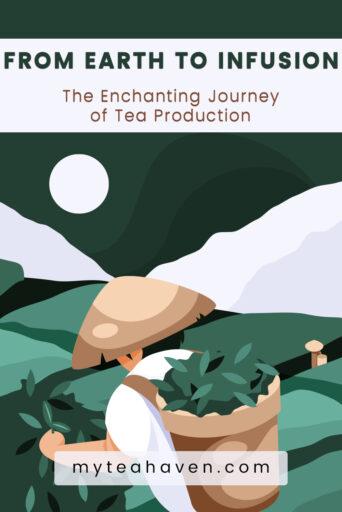
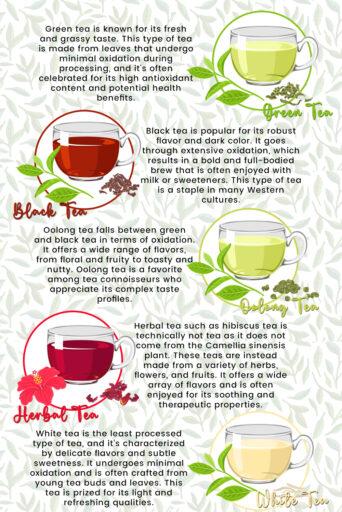
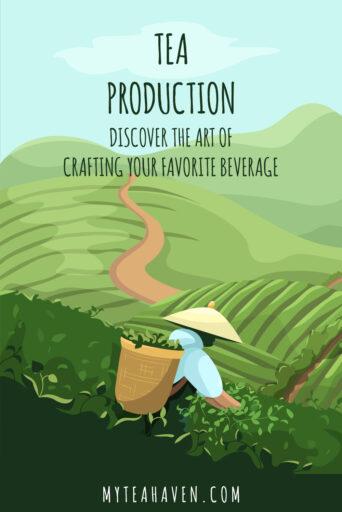
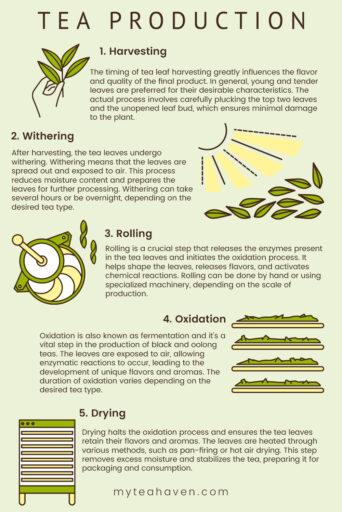
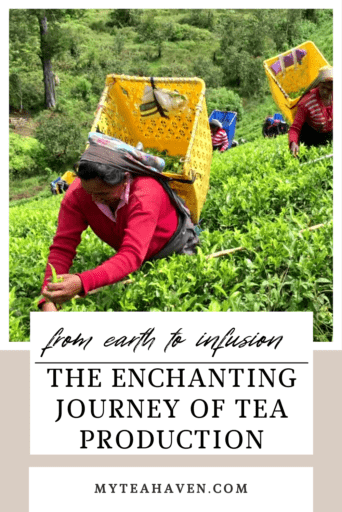



Comments are closed.